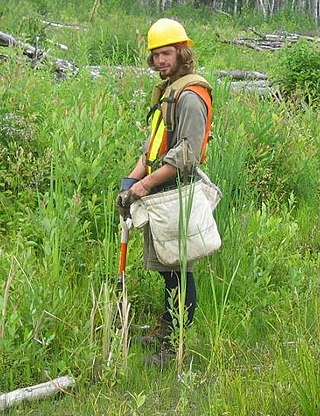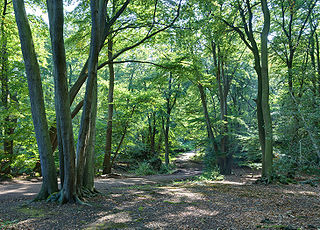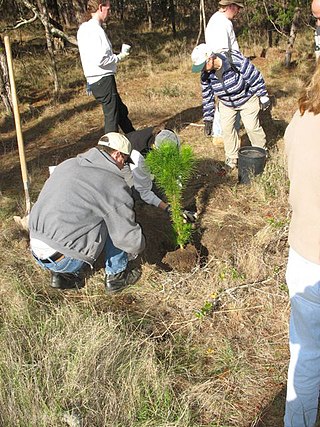
Arbor Day is a secular day of observance in which individuals and groups are encouraged to plant trees. Today, many countries observe such a holiday. Though usually observed in the spring, the date varies, depending on climate and suitable planting season.
The conservation movement, also known as nature conservation, is a political, environmental, and social movement that seeks to manage and protect natural resources, including animal, fungus, and plant species as well as their habitat for the future. Conservationists are concerned with leaving the environment in a better state than the condition they found it in. Evidence-based conservation seeks to use high quality scientific evidence to make conservation efforts more effective.

Forestry is the science and craft of creating, managing, planting, using, conserving and repairing forests and woodlands for associated resources for human and environmental benefits. Forestry is practiced in plantations and natural stands. The science of forestry has elements that belong to the biological, physical, social, political and managerial sciences. Forest management plays an essential role in the creation and modification of habitats and affects ecosystem services provisioning.

The Woodland Trust is the largest woodland conservation charity in the United Kingdom and is concerned with the creation, protection, and restoration of native woodland heritage. It has planted over 50 million trees since 1972.
The Forestry Commission is a non-ministerial government department responsible for the management of publicly owned forests and the regulation of both public and private forestry in England.

Tree planting is the process of transplanting tree seedlings, generally for forestry, land reclamation, or landscaping purposes. It differs from the transplantation of larger trees in arboriculture and from the lower-cost but slower and less reliable distribution of tree seeds. Trees contribute to their environment over long periods of time by providing oxygen, improving air quality, climate amelioration, conserving water, preserving soil, and supporting wildlife. During the process of photosynthesis, trees take in carbon dioxide and produce the oxygen we breathe.

The Department for Environment, Food and Rural Affairs (Defra) is a department of His Majesty's Government in the United Kingdom responsible for environmental protection, food production and standards, agriculture, fisheries and rural communities in the entire United Kingdom. Concordats set out agreed frameworks for co operation, between it and the Scottish Government, Welsh Government and Northern Ireland Executive, which have devolved responsibilities for these matters in their respective nations.

Urban forestry is the care and management of single trees and tree populations in urban settings for the purpose of improving the urban environment. Urban forestry involves both planning and management, including the programming of care and maintenance operations of the urban forest. Urban forestry advocates the role of trees as a critical part of the urban infrastructure. Urban foresters plant and maintain trees, support appropriate tree and forest preservation, conduct research and promote the many benefits trees provide. Urban forestry is practiced by municipal and commercial arborists, municipal and utility foresters, environmental policymakers, city planners, consultants, educators, researchers and community activists.

Afforestation is the establishment of a forest or stand of trees (forestation) in an area where there was no recent tree cover. Many government and non-governmental organizations directly engage in afforestation programs to create forests and increase carbon capture. Afforestation is an increasingly sought-after method to fight climate concerns, as it is known to increase the soil quality and organic carbon levels into the soil, avoiding desertification. Afforestation is mainly done for conservational and commercial purposes.

Delamere Forest is a large wood in the village of Delamere in Cheshire, England. The woodland, which is managed by Forestry England, covers an area of 972 hectares making it the largest area of woodland in the county. It contains a mixture of deciduous and evergreen trees.
American Forests is a 501(c)(3) non-profit conservation organization, established in 1875, and dedicated to protecting and restoring healthy forest ecosystems. The current headquarters are in Washington, D.C.

The Sustainable Forestry Initiative (SFI) is a sustainability organization operating in the U.S. and Canada that works across four pillars: standards, conservation, community, and education. SFI was founded in 1994 by the American Forest & Paper Association (AF&PA). SFI is the world's largest single forest certification standard by area. SFI is headquartered in Ottawa and Washington, D.C.
The Mersey Forest is a network of woodlands and green spaces being created across Merseyside and North Cheshire by a wide-ranging partnership of different organisations including local authorities, community groups and businesses. The Mersey Forest is the biggest of twelve community forests covering 420 square miles (1,100 km2) and accessible to a local population of 1.6 million people. It stretches from Sefton to the north of Liverpool and south to Northwich in Cheshire. Delamere Forest in the south of the area being the largest area of established woodland. The forest is seen as having a major role in attracting new business and tourism to the area.
Casey Trees is a non-profit organization established in 2001 to restore, enhance, and protect the tree canopy of Washington, D.C. The organization plants trees, engages volunteers in tree planting and care, offers an education program open to the public, monitors the District's tree canopy, and advocates and plans for the urban forest.

The United Kingdom, being in the British Isles, is ideal for tree growth, thanks to its mild winters, plentiful rainfall, fertile soil and hill-sheltered topography. In the absence of people, much of Great Britain would be covered with mature oaks, except for Scotland. Although conditions for forestry are good, trees do face damage threats arising from fungi, parasites and pests. The development of afforestation and the production and supply of timber in Wales come under Natural Resources Wales, as set out in the Forestry Act 1967.

Air pollution in the United Kingdom has long been considered a significant health issue, and it causes numerous other environmental problems such as damage to buildings, forests, and crops. Many areas, including major cities like London, are found to be significantly and regularly above legal and recommended pollution levels. Air pollution in the UK is a major cause of diseases such as asthma, lung disease, stroke, cancer, and heart disease, and is estimated to cause forty thousand premature deaths each year, which is about 8.3% of deaths, while costing around £40 billion each year.
Environmental inequality in the United Kingdom is the way in which the quality of the environment differs between different communities in the UK. These differences are felt across a number of aspects of the environment, including air pollution, access to green space and exposure to flood risk.

Urban reforestation is the practice of planting trees, typically on a large scale, in urban environments. It may also include urban horticulture and urban farming.

Tree Canada is a non-profit charitable organization that promotes the planting and nurturing of trees in Canada's urban and rural areas. It provides tree-related education, technical assistance and resources to communities, corporations, individuals and non-profit organizations.

A community orchard is a collection of fruit trees shared by communities and growing in publicly accessible areas such as public greenspaces, parks, schools, churchyards, allotments or, in the US, abandoned lots. Such orchards are a shared resource and not managed for personal or business profit. Income may be generated to sustain the orchard as a charity, community interest company, or other non-profit structure. What they have in common is that they are cared for by a community of people.

















